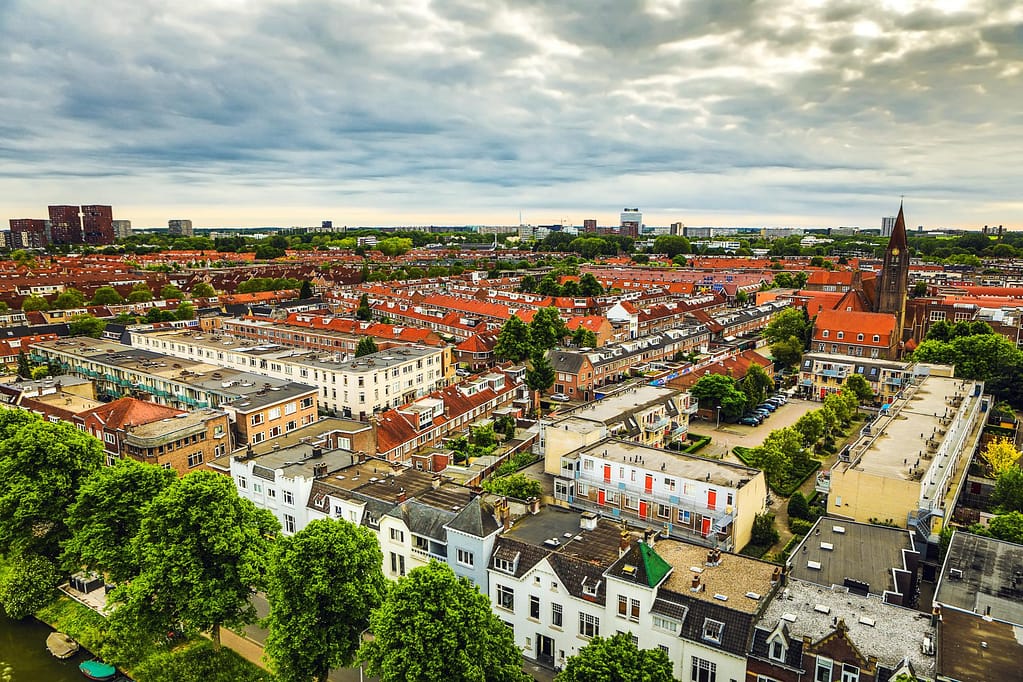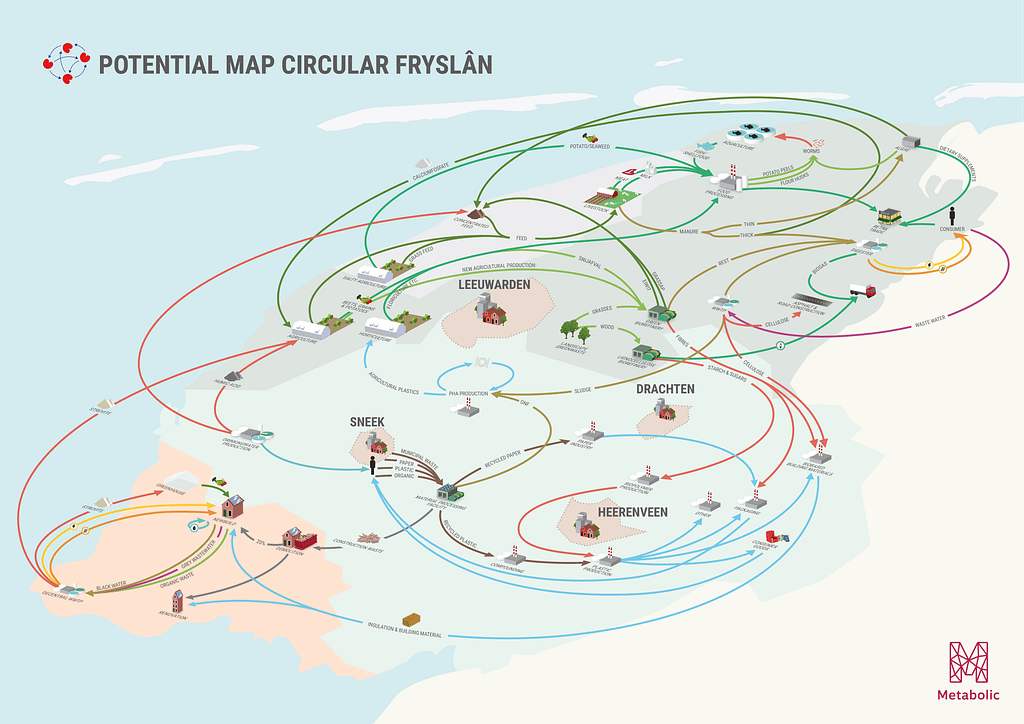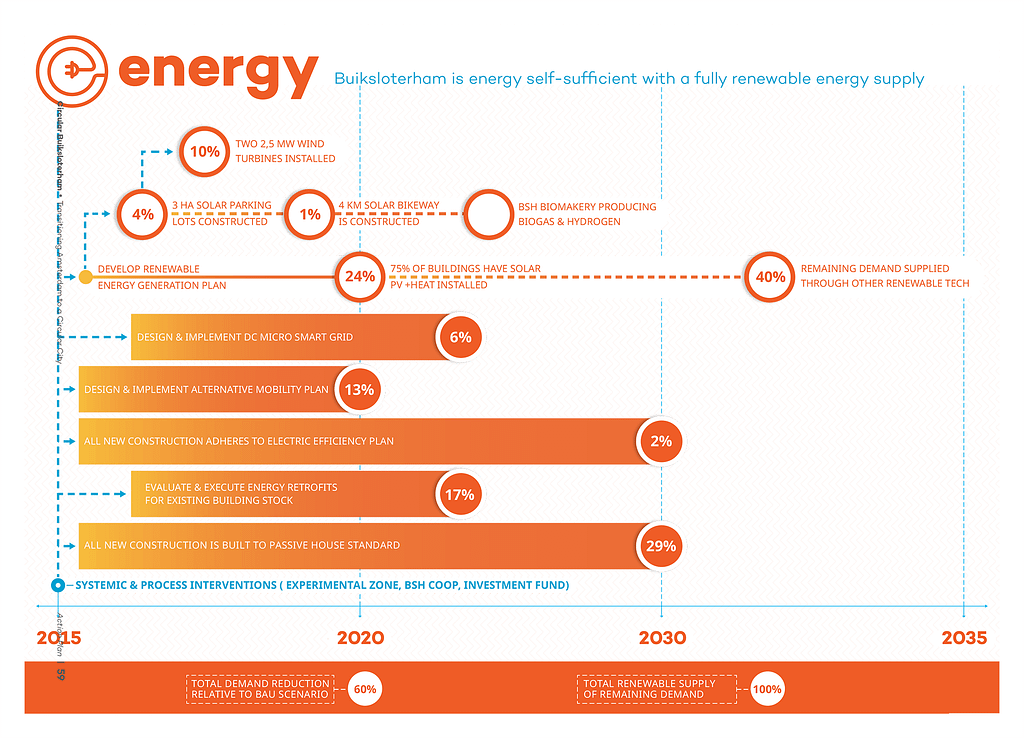Ever since Metabolic was founded in 2012, we have looked at how we can achieve circularity by applying the rules of natural ecosystems to cities and metropolitan regions. This is what we have learned.
At Metabolic, we have been studying sustainable urban development and circular cities for 12 years. One way in which we have approached this is by looking at cities and regions as natural ecosystems: the idea of the urban metabolism. Analyzing human production and consumption processes in this way allows us to understand cities and metropolitan regions in a holistic and comprehensive manner. And it facilitates a data-driven approach to changing them. One essential tool for understanding the way an urban metabolism works is a material flow analysis (MFA), which maps a city’s material, energy, and water flows.
How to identify circular opportunities
In a circular city, materials are cycled at high quality, all energy is derived from renewable or otherwise sustainable sources, and natural and human capital is structurally supported rather than degraded through economic activities. But no two cities are the same, and there are many different routes to circularity. This is where MFAs come in: they can help cities and regions identify circular opportunities, utilize strategic interventions and implement policy developments.
In the past 12 years, we have conducted MFAs for more than 40 neighborhoods, cities, and regions. Let’s uncover what we have learned…
Circular neighborhoods, circular regions
MFAs can be applied on many scales, from neighborhoods through to entire regions. We have conducted MFAs for events – such as the DGTL music festival – neighborhoods, cities, for example Copenhagen and Utrecht, and even the global economy. One of our very first urban MFAs, conducted in 2014, considered the current and projected urban metabolism of Amsterdam’s Buiksloterham neighborhood, a 100-hectare post-industrial site in North Amsterdam. Based on our MFA, we developed a vision, roadmap, and action plan for the area to transition to a fully circular neighborhood. Today, Buiksloterham has become a globally renowned example of circular urban development.

A tailor-made approach to the circular transition
While large urban areas are essential for the transformation to a circular economy, smaller-scale systems can be effective in testing promising circular interventions. We have analyzed these types of smaller urban systems, too, for example in the Dutch municipality of Harderwijk and the municipalities of the Wadden Islands in the North Sea. Each MFA analysis pinpoints exactly where the biggest issues can be found – for example in waste streams, consumption of building materials, municipal procurement – allowing local governments and other stakeholders to prioritize which interventions to apply.
On a larger geographical scale, circular systems may be achieved through policies and subsidies, whereas on a smaller scale, interventions could include setting up or supporting circular economy programs or facilitating circular networks.
The following longer-term case studies demonstrate what a difference our MFAs have made over time.
Circular Friesland: creating a network of more than 160 organizations
In 2015, the province of Friesland approached us with the request for help in shaping the new circular economy. There was broad support for this across the province. From construction companies to salt farmers and from municipalities to waste companies, a wide range of stakeholders saw the potential to create new jobs and environmentally sustainable economic growth. With a regional MFA and a participatory stakeholder process, we identified circular opportunities that could be developed as landmark projects in partnership with the stakeholders. Currently, the Circular Friesland network consists of approximately 160 companies, local government organizations, educational institutions, and social organizations, and that number keeps growing. The network’s members are setting ambitious targets for a sustainable Friesland, and a sustainable world, through realizing circular procurement, which the Frisian authorities have officially committed to. Circular Friesland also develops and scales up circular entrepreneurship through leveraging legislation and regulations – regional, national, and European – because it has become clear that this can have a considerable effect. Metabolic is still involved in the network, too, helping with various projects and communications.

A long-term partnership and circular strategies with the City of Amsterdam
Our 2014 MFA for Buiksloterham, which showcased the Amsterdam neighborhood’s potential for becoming a leading example for circular city development, led to much wider ambitions on the side of the City of Amsterdam. Eventually, our research inspired the plan to implement a circular economy in the entire city, creating a strategy with ambitious targets, such as reducing the use of new virgin materials by 50% by 2030 and achieving a fully circular city by 2050. Currently, Metabolic is working with the City of Amsterdam on projects focusing on leveraging policy and regulations for circularity, further circular urban development in North Amsterdam, and circular innovation and entrepreneurship in Amsterdam and the Netherlands.

An inspirational circular economy hub in the City of Charlotte
Further afield, we helped establish the City of Charlotte, in North Carolina, as a leading green city in the US. In 2018, an MFA was the first step to help the city create a vision and coordinated roadmap towards a circular economy. The MFA showed that 88% of the city’s waste was going to landfill, which was filling up fast. The Metabolic study proposed five circular business cases, which together could divert up to 15% of the waste from landfill, create up to 492 new jobs, and generate up to $34 million in revenues. One of these proposals, which we helped put into action, is the Innovation Barn, a hub that showcases circular practices in action. It has become an incredibly inspirational circular hub in the city. The Innovation Barn includes a material innovation lab, which is being approached by companies with various types of resource streams, working with them to prototype different uses for those materials. It also works on repurposing significant amounts of glass and concrete. The Barn furthermore saves and redistributes hundreds of thousands of pounds of food to disadvantaged families. Its onsite cafe has a training program for homeless people, providing job opportunities.
The examples of Buiksloterham, Friesland and Charlotte show how MFAs can be applied in different circumstances, and what a wide variety of results can be achieved with them. And over the past 12 years, we have constantly refined this process, leading to our MFAs now being more detailed than ever.

A solid foundation for sustainable urban development
Transforming cities is one of the largest leverage points in moving towards an economy that works within the limits of our planet. And while the outcomes of all our MFA research have similarities in terms of impact points and potential circular interventions, each project is accompanied by an in-depth analysis of the specific neighborhood, city or region. In our experience, this process is a crucial part of any city’s journey to become more circular. And we have seen it have an enormous impact on activating and motivating local governments, businesses and citizens to build better cities for their shared future.
Find out more
Contact us to learn more about a material flow analysis for your neighborhood, city or region.




